
“No sentence can be effective if it contains facts alone. It must also contain emotion, image, logic, and promise.”
– Copywriter and Author, Eugene Schwartz
Of all the ways your brand expresses its value to connect with customers, there are few more powerful than your website’s headline. This key brand message has to do an incredible amount of work within a very small number of words.
The overarching question your headline has to address for your customers is:
“How will my life be better as a result of engaging with your brand?”
It’s important to note that this is a very different question than simply asking:
“What is this thing you’re selling?”
The difference is the shift from feature-focused messaging to benefit-focused messaging.
It means going beyond describing your product or service and explaining how it will shift your customer’s life into a better future state.
That’s what the quote from legendary copywriter Eugene Schwartz sums up perfectly.
“No sentence can be effective if it contains facts alone…” — these are your features. It’s not to say that facts and features don’t have a place in your headline and key messages, it’s that they won’t be effective alone.
“…it must also contain emotion, image, logic, and promise.” — this is the shift needed to tap into the motivations and outcomes that drive your customers to engage and purchase.
What’s particularly great about this quote is that it provides some clear criteria that we can use to evaluate the effectiveness of a headline.
We can use those four elements — emotion, image, logic, promise — as a checklist to test if a headline has a good chance of successfully driving customers to action.
To better understand these ideas, we can look at examples out in the wild and see how different brands deliver on each of these critical components.
Headline Focus – Emotion: Headspace
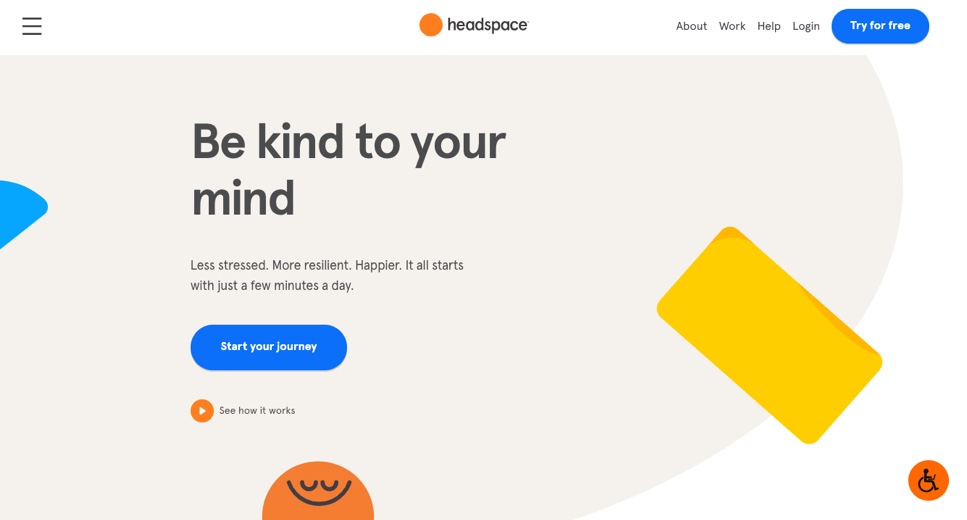
Headspace has always been very skilled in positioning their mediation app around benefits. In fact, the word “meditation”, a key fact about the brand’s offering, doesn’t even appear in this masthead.
Instead, within the span of five short words, they manage to create context around mental health (“your mind”) and create an emotional connection to the value of it (“Be kind”).
During a time when anxiety levels are high around health, politics, job security, etc. there’s an immediate emotional comfort in seeing a service that provides an antidote to that.
How to use emotion in your own headline:
Emotion gets triggered in lots of different ways with your headline. The Headspace example is fairly straightforward, as there are close ties between kindness and the positive emotions we associate with that action.
But you can also evoke emotion with words that relate to surprise and delight, inspiration, or even trigger fear.
Because so many headlines fail to capture any emotion, emotional trigger words tend to stand out, get your customer’s attention, and make your message more memorable.
Headline Focus – Image: Mirror
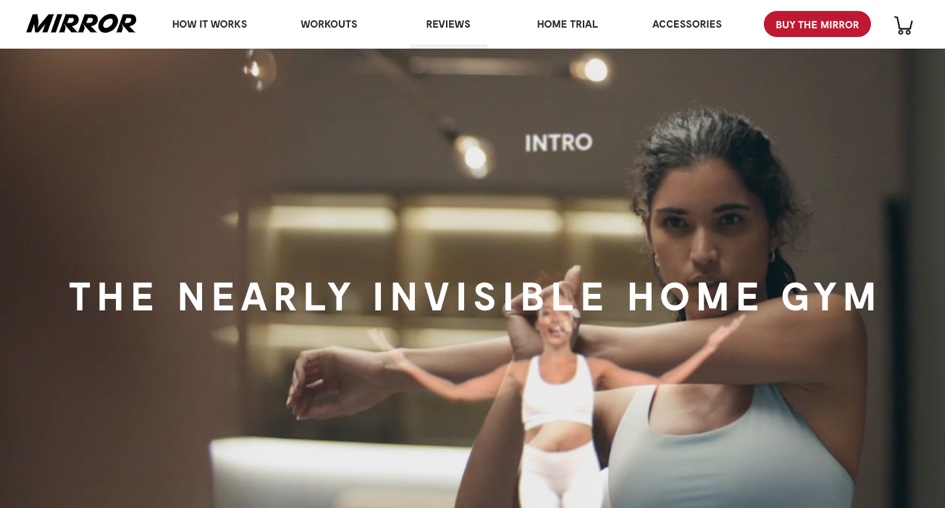
In the category of home fitness, Mirror has one particularly big advantage — it has zero footprint in your home.
Their headline does a fantastic job of creating a clear, memorable mental image of this idea by describing their “gym” as “nearly invisible”.
For anyone with limited space or that’s suffered though having old exercise equipment collect dust in their home, this paints an exciting picture of a new possibility.
How to use image in your own headline:
Look for ways that you can help customers see what their life would be like if they used your product or service. By painting that picture for them, it helps to make that improved future state feel grounded and real.
A big key with making a visual image like this impactful in your headline is to be specific. Focus on one specific aspect of the offering that’s notable.
And remember, this doesn’t only apply to physical products. You can describe an image of a place, a moment, or even use a visual metaphor.
Headline Focus – Logic: JUDY
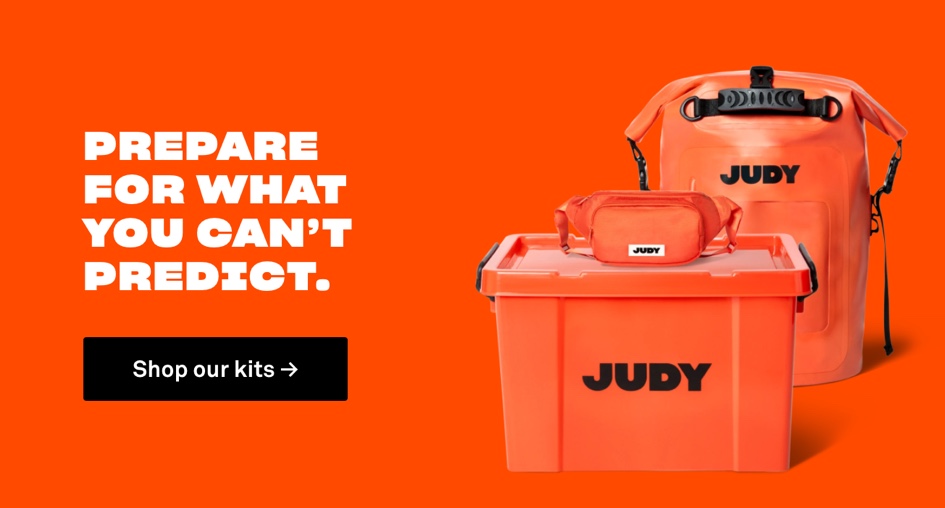
Logic is a tricky concept with a headline because it’s easy to get overly complex and force your customer to think too much. That can spell death for a headline, causing customers to reject or ignore the message completely.
JUDY, the emergency kit provider, walks that balance skillfully here. They manage to pack in the right amount of logic without requiring deep thought.
It takes very little brain power to grasp that there are certain things in life that are out of our control. And those events can be some of the most dangerous if you’re not prepared.
That combination of logic along with some light fear-based emotion drives home the benefit of the brand.
How to use logic in your own headline:
Again, this is an element that can be powerful as long as it’s used with caution. If your headline’s logic creates too much cognitive load for your customer at best they may skip it. At worst it creates confusion and frustration and prompts customers to leave.
Your goal should be to use a logic statement that would be obvious to your target customer on a gut level and that ties back to a clear benefit of your brand.
One simple formula to use is:
- If you agree with X…
- Then the perfect solution is Y.
Using the JUDY example, this would translate to:
- If you agree there are life events you can’t predict…
- Then the perfect solution is a preparedness kit.
Once the logic structure is in place, you can work to tighten the language into a concise marketing statement.
Headline Focus – Promise: Magic Spoon
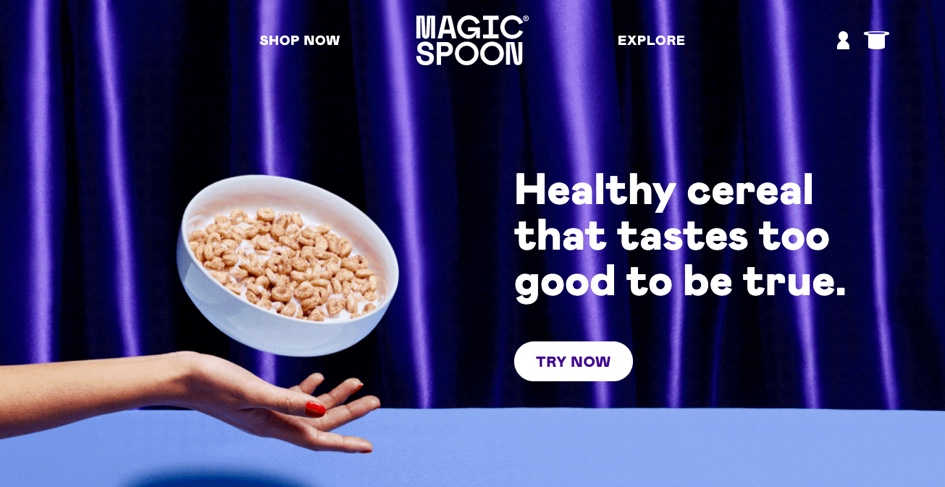
One of the best known trade-offs when it comes to food is if something tastes good it probably means it’s not good for you.
Magic Spoon decided to take that idea head-on, with cereal for adults that’s healthy and tastes delicious..
Their website’s headline captures that idea in a succinct brand promise — “Healthy cereal that tastes too good to be true.” It presents a very appealing benefit that piques the customer’s interest to find out how they pulled off this magical combination.
How to use emotion in your own headline:
In many ways, a promise is the most straight forward, classic approach for a headline. It speaks straight to the benefit or value that your brand provides to customers.
The key with an effective promise headline is that it’s authentic and grounded in what your brand provides. It also has to be something that your brand delivers consistently.
To nail the right promise for your headline, you need a deep understanding of who your customers are and what benefit is most top of mind for them. The only way to capture that is to talk to both existing and potential customers. By talking and listening to them, you can learn what needs they care about most and what language they use to describe it.
Map & Fire’s Own Example
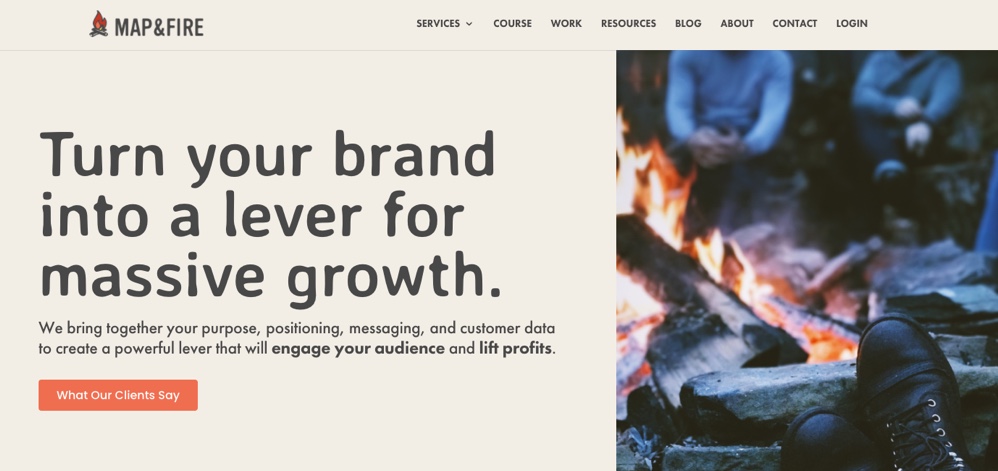
Finally, we’ll turn the microscope on our own brand for a minute. This is how the current Map & Fire website headline aims to hit on these same headline ingredients:
- Image: The headline doesn’t describe an actual object, but instead takes the abstract idea of your brand and compares it to a physical lever. A lever is a tool that provides a mechanical advantage. In our metaphor, the brand-lever provides a strategic advantage — specifically one that can help your business engage a large number of customers.
- Logic: For this concept to work it assumes a small bit of logic around why levers are useful. It’s a simple comparison though, as the idea of having leverage is well understood in the business services space.
- Emotion: On the emotional side, the main focus is the size of the impact your brand can have and keying in on the word “massive”. This helps evoke a level of excitement around the true potential of the work.
- Promise: Our goal with every client we work with is to bring all the elements of your business (purpose, positioning, messaging, data) together into a unified brand. With that foundation in place, it allows your marketing, customer service, and internal culture to work cohesively to create growth.
Elevate Your Headline Beyond Facts Alone
As the quote from Eugene Schwartz states, facts are fine but to make your messaging effective it can’t end there.
Your website’s headline can be an incredible tool to convey your brand’s value and show customers how your offerings will improve their lives. If your messaging doesn’t paint that picture effectively, customers are much more likely to forget your brand and move on.
Use the criteria of emotion, image, logic, and promise to grade your headline and see if it’s contributing to a positive first impression for your customers. It takes a little bit of extra work, but the results can be huge.

Get Help Creating Effective Messaging
If you’re ready to build stronger connections with your customers, reach out for a free consultation. We’ll help you transform your best business thinking into an actionable, shareable, growth-oriented guide. Click below to learn more about the Brand Guidebook process.

